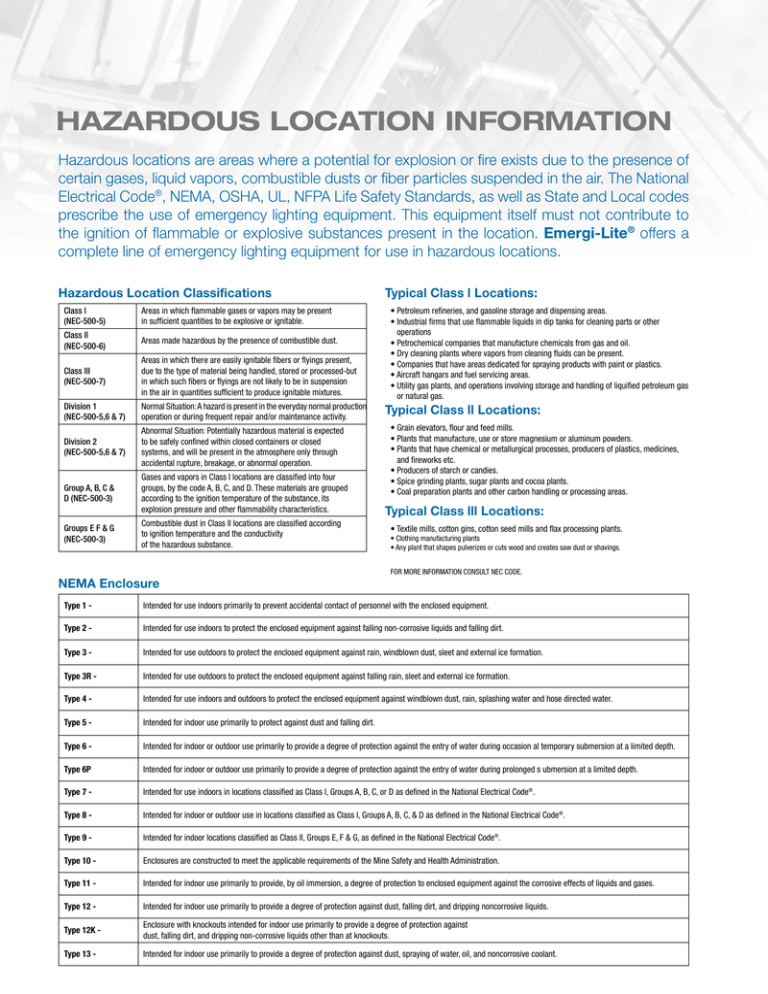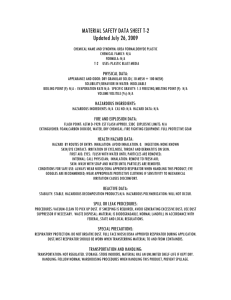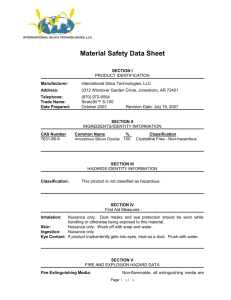Hazardous Locations - Emergi-Lite
advertisement

HAZARDOUS LOCATION INFORMATION Hazardous locations are areas where a potential for explosion or fire exists due to the presence of certain gases, liquid vapors, combustible dusts or fiber particles suspended in the air. The National Electrical Code®, NEMA, OSHA, UL, NFPA Life Safety Standards, as well as State and Local codes prescribe the use of emergency lighting equipment. This equipment itself must not contribute to the ignition of flammable or explosive substances present in the location. Emergi-Lite® offers a complete line of emergency lighting equipment for use in hazardous locations. Hazardous Location Classifications Class l (NEC-500-5) Areas in which flammable gases or vapors may be present in sufficient quantities to be explosive or ignitable. Class ll (NEC-500-6) Areas made hazardous by the presence of combustible dust. Class lll (NEC-500-7) Areas in which there are easily ignitable fibers or flyings present, due to the type of material being handled, stored or processed-but in which such fibers or flyings are not likely to be in suspension in the air in quantities sufficient to produce ignitable mixtures. Division 1 (NEC-500-5,6 & 7) Normal Situation: A hazard is present in the everyday normal production operation or during frequent repair and/or maintenance activity. Division 2 (NEC-500-5,6 & 7) Abnormal Situation: Potentially hazardous material is expected to be safely confined within closed containers or closed systems, and will be present in the atmosphere only through accidental rupture, breakage, or abnormal operation. Group A, B, C & D (NEC-500-3) Gases and vapors in Class l locations are classified into four groups, by the code A, B, C, and D. These materials are grouped according to the ignition temperature of the substance, its explosion pressure and other flammability characteristics. Groups E F & G (NEC-500-3) Combustible dust in Class ll locations are classified according to ignition temperature and the conductivity of the hazardous substance. NEMA Enclosure Typical Class l Locations: • Petroleum refineries, and gasoline storage and dispensing areas. • Industrial firms that use flammable liquids in dip tanks for cleaning parts or other operations • Petrochemical companies that manufacture chemicals from gas and oil. • Dry cleaning plants where vapors from cleaning fluids can be present. • Companies that have areas dedicated for spraying products with paint or plastics. • Aircraft hangars and fuel servicing areas. • Utility gas plants, and operations involving storage and handling of liquified petroleum gas or natural gas. Typical Class ll Locations: • Grain elevators, flour and feed mills. • Plants that manufacture, use or store magnesium or aluminum powders. • Plants that have chemical or metallurgical processes, producers of plastics, medicines, and fireworks etc. • Producers of starch or candies. • Spice grinding plants, sugar plants and cocoa plants. • Coal preparation plants and other carbon handling or processing areas. Typical Class lll Locations: • Textile mills, cotton gins, cotton seed mills and flax processing plants. • Clothing manufacturing plants • Any plant that shapes pulverizes or cuts wood and creates saw dust or shavings. FOR MORE INFORMATION CONSULT NEC CODE. Type 1 - Intended for use indoors primarily to prevent accidental contact of personnel with the enclosed equipment. Type 2 - Intended for use indoors to protect the enclosed equipment against falling non-corrosive liquids and falling dirt. Type 3 - Intended for use outdoors to protect the enclosed equipment against rain, windblown dust, sleet and external ice formation. Type 3R - Intended for use outdoors to protect the enclosed equipment against falling rain, sleet and external ice formation. Type 4 - Intended for use indoors and outdoors to protect the enclosed equipment against windblown dust, rain, splashing water and hose directed water. Type 5 - Intended for indoor use primarily to protect against dust and falling dirt. Type 6 - Intended for indoor or outdoor use primarily to provide a degree of protection against the entry of water during occasion al temporary submersion at a limited depth. Type 6P Intended for indoor or outdoor use primarily to provide a degree of protection against the entry of water during prolonged s ubmersion at a limited depth. Type 7 - Intended for use indoors in locations classified as Class l, Groups A, B, C, or D as defined in the National Electrical Code®. Type 8 - Intended for indoor or outdoor use in locations classified as Class l, Groups A, B, C, & D as defined in the National Electrical Code®. Type 9 - Intended for indoor locations classified as Class ll, Groups E, F & G, as defined in the National Electrical Code®. Type 10 - Enclosures are constructed to meet the applicable requirements of the Mine Safety and Health Administration. Type 11 - Intended for indoor use primarily to provide, by oil immersion, a degree of protection to enclosed equipment against the corrosive effects of liquids and gases. Type 12 - Intended for indoor use primarily to provide a degree of protection against dust, falling dirt, and dripping noncorrosive liquids. Type 12K - Enclosure with knockouts intended for indoor use primarily to provide a degree of protection against dust, falling dirt, and dripping non-corrosive liquids other than at knockouts. Type 13 - Intended for indoor use primarily to provide a degree of protection against dust, spraying of water, oil, and noncorrosive coolant.



